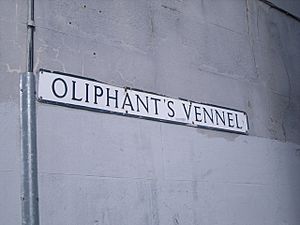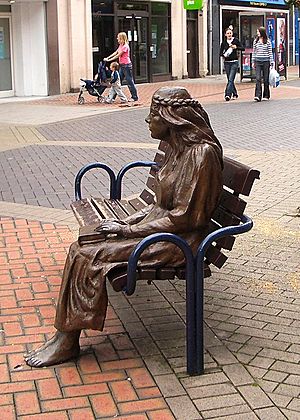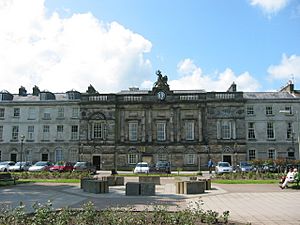History of Perth, Scotland facts for kids
Perth (Scottish Gaelic: Peairt) is a city in central Scotland. People have lived in Perth since ancient times. Finds show that Mesolithic hunter-gatherers were here over 8,000 years ago. Later, Neolithic standing stones appeared when farming began around 4000 BC. A very old Bronze Age log boat from about 1000 BC was found in the River Tay. A Roman legionary fort was also built nearby.
Contents
Early History of Perth
The name Perth comes from a Pictish word meaning 'wood'. The Picts were an ancient people in Scotland. They later joined with the Scots to form the kingdom of Alba, which became Scotland. For much of the Middle Ages, Perth was called "St. John's Toun". This was because its main church was for St. John the Baptist.
Archaeological finds suggest Perth has been settled for a long time. It was likely built where people could cross the River Tay. The town was on a slightly raised area, which helped protect it from floods. Nearby Scone was a royal center from the 800s. It later had a large abbey. This made Perth very important. For a long time, Perth was like the 'capital' of Scotland. Kings of Scots were crowned at Scone Abbey on the famous Stone of Scone.
Perth in the 12th and 13th Centuries
King David I made Perth a 'burgh' (a special town) in the early 1100s. Perth became one of the richest trading towns in Scotland. Many skilled workers lived here, like metalworkers and glovers. They were organized into groups called guilds. Perth also traded a lot with other countries. They imported luxury goods like Spanish silk and French pottery. Wine was also a major import. Old street names in Perth still remind us of these medieval crafts.
A big flood of the River Tay destroyed the royal castle in 1209. This was one of many floods Perth has faced. King William I helped Perth keep its burgh status. Perth remained the main city of Scotland for a while.
English Occupation in the 14th Century
King Edward I of England brought his armies to Perth in 1296. The town had only a ditch for defense and fell quickly. The English quickly built stronger defenses. They planned to build walls around the town in 1304. These walls stood until Robert the Bruce recaptured Perth in 1312. He ordered the defenses to be destroyed.
In 1332, Edward Balliol tried to claim the Scottish throne. He had the support of Edward III of England. Robert the Bruce had died, and the Scottish regent was defeated. Balliol took Perth and the throne. This started a Scottish Civil War. Balliol was driven out but returned the next year. His rule ended in 1336. His supporters were finally driven from Perth in 1339.
To make Perth a permanent English base, King Edward III forced monasteries to pay for new, strong stone walls. These walls had towers and fortified gates. They were the strongest defenses of any town in Scotland during the Middle Ages. The town's water channel, called a 'lade', also helped defend the walls. The walls had several gates, like the Red Brig Port and Southgait Port. Most of these defenses were torn down from the late 1700s. Today, no visible parts remain above ground.
Later Medieval Times and the 15th Century
During the Middle Ages, Perth's main church was St. John the Baptist. Perth also had many other religious buildings. These included houses for different groups of monks, like the Dominicans and Franciscans. Scotland's only Carthusian Priory, called the "Charterhouse", was also in Perth.
A famous trial by combat happened in Perth in 1396. Two Clans, Clan Chattan and Clan Cameron, each with thirty fighters, battled at the town's North Inch. King Robert III and his court watched this event. Clan Chattan is believed to have won the battle.
King James I was killed in 1437 by rebel noblemen. This happened in the house of the Dominicans. Perhaps because of this, James was the last king to rule from Perth. The capital of Scotland was moved to Edinburgh in 1437.
16th to 18th Centuries
In 1559, John Knox began the Scottish Reformation in Perth. He gave a sermon against 'idolatry' in St. John the Baptist church. An angry crowd then destroyed altars in the church. They also attacked the houses of the monks and the Carthusian Priory. Scone Abbey was also damaged soon after. The mother of Mary, Queen of Scots, Marie de Guise, stopped the riots. But Presbyterianism remained strong in Perth.
There are no visible remains of Perth's old religious buildings today. Their locations are remembered in modern street names. In August 1600, King James VI of Scotland visited Gowrie House. Due to a misunderstanding or a plot, the king's men killed the Earl of Gowrie and his sons.
Charles II was crowned at Scone in 1651. But within a year, Oliver Cromwell's armies came to Perth. Cromwell built a fort on the South Inch in 1652. This was one of five forts built in Scotland to control the country. Perth's hospital, bridge, and many houses were torn down to build this fort. Even gravestones were used. The fort was given back to the town in 1661 and soon taken apart.
The return of Charles II to the throne led to the Jacobite Risings. Perth supported the Jacobites and was occupied by them three times (1689, 1715, and 1745).
Perth from the Late 18th Century to Today
In 1760, a new building for Perth Academy was started. Major industries came to the town, which now had about 15,000 people. Linen, leather, bleached products, and whisky were its main exports. Perth had been an important port for hundreds of years. A military base, Queen's Barracks, was built in 1793.
In the 1820s, piped water and gas became available in Perth. Electricity arrived in 1901. The Perth Royal Infirmary hospital was built in 1838. It moved to a new building in 1914 because it needed more space. This made it one of the first hospitals in Scotland to use X-rays.
Perth became a key transport center when railways arrived. The first railway station was built in 1848. Horse-drawn carriages were popular in the 1890s. They were soon replaced by electric trams.
During the Second World War, Perth's main cemetery, Wellshill Cemetery, was made larger. This was to provide space for soldiers from the Free Polish Forces who were based in Scotland. Their graves are in a special section of the cemetery. The gravestones have the Polish eagle on them, and there is a Polish war memorial.
Images for kids
-
An indicative plan showing the medieval walls around Perth. The walls followed present day Murray Street, South Methven Street, Canal Crescent and Canal Street. Only one short part of the wall is still standing. The blue line marks the mill lade/ditches. The positions of gates (ports) and towers are marked including: (A) the site of Perth Castle; (B) Red Brig Port; (C) Turret Brig Port; (D) South Street Port; (E) Spey Tower; and (F) Monk's Tower





